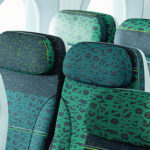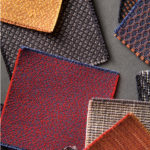Complete Fabrication: How Technology Weaves Into Cabin Textiles
Share
This article originally appeared in The Technology Issue of APEX Experience.
Fabric developments affect many key factors for airlines, including comfort, durability, maintainability, ecology, noise absorption and that perennial old chestnut: cost reduction.
Compared with advances such as in-flight entertainment or mood lighting, technological leaps in the “comparably mature textile industry might not seem that exciting,” says Philipp Dahm managing director of Rohi, the Bavaria-based aviation fabric manufacturer.
Maybe not as exciting, but perhaps more significant:
Evolved textile technologies, rather than paradigm shifts, can often be more appropriate and effective for improving passenger comfort.
Take Rohi’s seat cover fabrics, for example. Evolving over a period of more than 80 years, the manufacturer’s seat cover fabrics have their origins in prestigious concert halls across the world, including philharmonic concert halls in Berlin, Cologne and Munich, and also Switzerland’s Scala Basel. Having worked with external acoustic engineers on auditorium projects, Rohi sees potential to improve passenger cabin comfort through in-flight noise reduction by applying the fabric technology lessons learned in developing and designing auditorium textiles.
From the Scottish Borders region, designer and manufacturer Replin Fabrics focuses its textile technology on in-flight maintainability and cost reduction. Replin Fabric Protection System (RFPS) is a trademarked system that involves coating individual fibers with protective particles, making its seat fabrics both water resistant and stain repellent, useful when unexpected turbulence results in a spot of red wine on a seat cover, for example. . Sales and marketing director Carla Wiseman explains that “[RFPS] protection means the fabric can be spot-cleaned in situ, thus reducing the frequency of dry cleaning – a savings to both the environment and the [pocketbook]!”
In the Swiss capital of Bern, Lantal Textile’s design director, Ilona Illing, envisions “future airline fabrics corresponding with the passenger, reacting to body temperature, to the music someone listens to, making traveling more comfortable for the individual.” To address these objectives, Lantal’s innovative Pneumatic Comfort System has replaced conventional cushions with pneumatic ones, which can be adjusted to the required comfort level of each passenger. The system is combined with acclimatizing polyester 3-D meshes that are covered with the airlines’ seat covers. Climatex’s chemical make-up of virgin wool and beechwood viscose renders the fabric fully biodegradable – in line with the airline industry’s growing awareness of sustainability issues.





